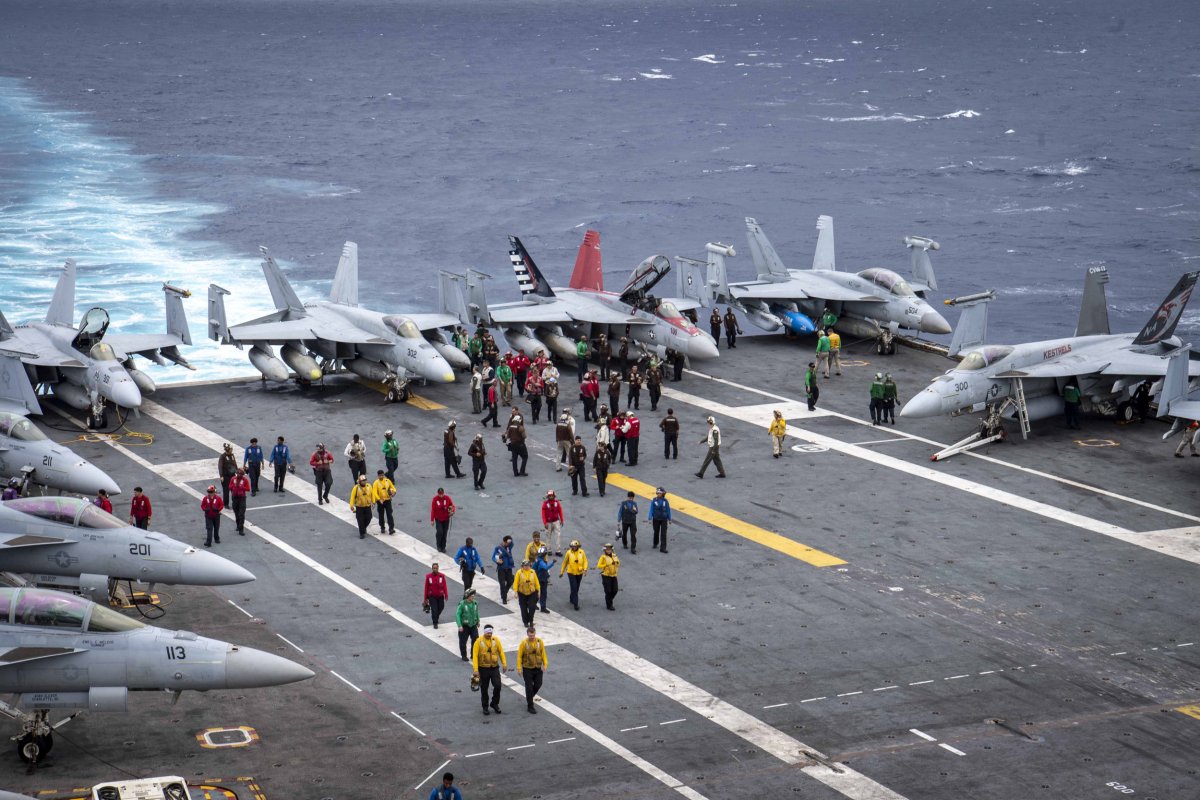The United States aircraft carrier USS Nimitz continues to operate in the South China Sea, satellite imagery shows, as the Chinese navy expands its presence in the Pacific Ocean.
The Seventh Fleet—the largest of the U.S. Navy‘s forward-deployed fleets, with more than 50 vessels and 150 aircraft—delivers “combat-credible forces” in the western Pacific and Indian Oceans alongside the U.S.’s allies and partners, the Fleet said in a statement to Newsweek.
Newsweek has also contacted the Chinese Defense Ministry for comment by email.
Why It Matters
The Nimitz began its “regularly scheduled deployment” to the western Pacific Ocean in late March—likely its final overseas mission before decommissioning. After a brief transit in the Strait of Malacca, the nuclear-powered warship returned to the South China Sea in late May.

United States Navy sailors checking the flight deck of the aircraft carrier USS Nimitz in the South China Sea on June 2.
Mass Communication Specialist Seaman Apprentice Franklyn Guage/U.S. Navy
The U.S. aircraft carrier deployment in the South China Sea, where China‘s territorial claims overlap those of other regional countries, comes as the Chinese navy—the world’s largest by hull count—has two aircraft carriers operating simultaneously in the broader western Pacific.
What To Know
According to satellite imagery captured on Sunday and shared by open-source intelligence researcher @MT_Anderson on X, formerly Twitter, the Nimitz was spotted operating in the West Philippine Sea, about 167 miles northeast of the disputed Scarborough Shoal.
🇺🇸Carrier Strike Group 11🇺🇸
CVN-68 is back in the West Philippine Sea, operating ~270km NE of 🇵🇭Scarborough Shoal (8 June 2025)Along with her are likely 2x Arleigh Burkes and potentially 1x 🇦🇺Hobart Class (?)
Length is in the correct range and it doesn’t look like a PLAN… pic.twitter.com/cHLqi13T22
— MT Anderson (@MT_Anderson) June 9, 2025
The maritime feature, under China’s control since 2012, lies about 138 miles west of Luzon Island in the northern Philippines. Manila uses the term “West Philippine Sea” to refer to the portion of the South China Sea that falls within its 230-mile-wide exclusive economic zone.
The most recently released official photos, taken on June 2, show the Nimitz underway in the South China Sea. The aircraft carrier’s deployment demonstrates the U.S. Navy’s unwavering commitment to a free and open Indo-Pacific, according to a photo caption.
Meanwhile, the second American aircraft carrier deployed in the western Pacific Ocean, USS George Washington, was spotted departing its home port at Yokosuka naval base near Tokyo, Japan‘s capital, on Tuesday, according to photos taken by a local ship spotter.
🇺🇸 原子力空母「ジョージ•ワシントン (USS George Washington)」が横須賀基地を威風堂々と出港しました。 pic.twitter.com/HVD1C2kby1
— ⚓︎アルザス⚓︎ (@Alsace_class) June 10, 2025
The George Washington returned to Yokosuka on June 4 following “routine operations” in nearby waters. The aircraft carrier and its naval aviators are preparing for their first patrol since returning to Japan—a U.S. ally—for a forward deployment almost eight months ago.
What People Are Saying
The U.S. Seventh Fleet said in a statement to Newsweek: “Every day the U.S. Pacific Fleet operates to protect the security, freedom, and prosperity for the United States and our allies and partners, reflecting our commitment to maintaining peace and stability in the region.”
The Seventh Fleet is one of two fleets—along with the Third Fleet—that report to the Pacific Fleet, whose command area extends from the Pacific Ocean to the Indian Ocean.
U.S. Navy Rear Admiral Maximilian Clark, the commander of the Nimitz Carrier Strike Group, said in April: “Operating forward as a strike group hones our ability to maintain persistent and capable forces at sea, always ready to provide our leaders with a broad spectrum of military capabilities to respond to any crisis or contingency.”
What Happens Next
It remains to be seen whether the Nimitz will depart the South China Sea for the Philippine Sea—located east of the Philippines—to conduct operations with the George Washington.




![[News] China’s Open-Source AI Push Expands After DeepSeek, as Baidu and Huawei Launch New Models](https://koala-by.com/wp-content/uploads/2025/07/Baidu-Ernie-model-624x416.jpg)



